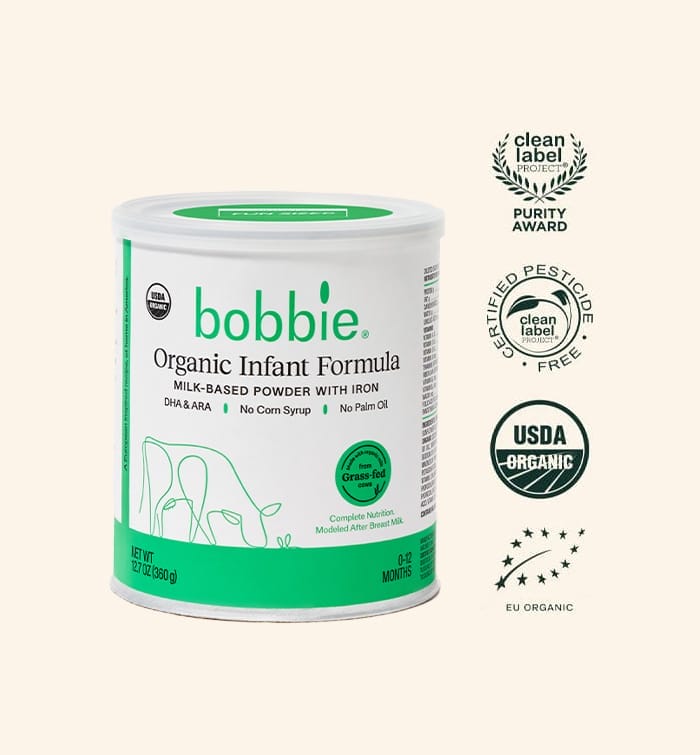We are proud to say that these posts are not sponsored. Our editorial team of Bobbie moms and writers personally select each featured product. If you buy something through our links, we may earn an affiliate commission, at no cost to you.
Going from breastfeeding or formula feeding to doing both bottles and baby foods can feel overwhelming. You may already be navigating how and when to transition off formula or breast milk. Now that you have finished formula feeding, you have to plan meals and snacks, too! Not to mention figuring out a new feeding schedule for your 1-year-old.
- Your Baby’s Growth at 12 months
- How Many Feeds Should A 1-Year-Old Have?
- How Often And How Much Do You Need To Feed Your 1-Year-Old?
- How Long Should a 1-Year-Old Go Between Meals and Snacks?
- How Many Bottles A Day Should A 1-Year-Old Have?
- How Many Milk Feeds Should A 12-Month-Old Have?
- What Foods Should A 1-Year-Old Avoid?
- 3 Sample Meal Plans for 1-Year-Olds
- How to Accommodate Picky Eaters
As a mom who just went through this phase, I can say that routine is key. Try to offer meals and snacks on a consistent schedule every day, if possible. Toddlers love predictability. Anticipating their next snack or meal can help keep them from constantly asking for snacks or grazing all day long.
Schedules will look different for every family, but aim to serve breakfast upon waking, followed by a mid-morning snack, lunch, afternoon snack, and dinner. If your child(ren) likes to eat dinner early, you also might consider offering a pre-bedtime snack. Just keep this snack “boring” so they don’t skip dinner in favor of their bedtime snack.
Through it all, remember that it’s normal for toddler eating habits to be unpredictable. They may be a bottomless pit one day, only to be satisfied after a just a few bites the next. They may fill up at breakfast and lunch, and eat less at dinnertime. And one thing you’ll learn quickly is that the food they loved yesterday, they can’t stand today.

Shop Bobbie Organic Infant Formula
Bobbie Organic Infant Formula is a USDA Organic, EU-style infant formula that meets all FDA requirements. It is a complete nutrition milk-based powder modeled after breast milk and is easy on tummies. It is non-GMO and doesn't have corn syrup, palm oil, or maltodextrin. Learn more about Bobbie.
Your Baby’s Growth at 12 months
You probably noticed your baby getting increasingly mobile as they neared 12 months. By one year, your baby should be crawling, and they may be pulling up to stand, taking a few steps on their own, or full-on walking.
They’ve likely mastered the pincer grasp—which will come in handy as they start eating table foods and feeding themselves. A one-year-old can also start drinking from a straw cup or sippy cup, if they haven’t already. The AAP recommends holding off on open cups until your little one can handle it without spilling, around age 2.
Another thing you may have noticed about your one-year-old is that their growth rate is beginning to slow. In the first few months of life, most babies gain weight pretty quickly—like 4 pounds in four months or less, according to the AAP. But once they hit the 12-month mark, they’re likely to only gain 3-5 pounds total over the next year.
There is a huge range of “normal” sizes for 1-year-olds, so just make sure you’re tracking your little one’s measurements and that they’re continuing to follow their own unique growth curve on the week by week growth chart. That said, according to the AAP, the average 15-month-old girl weighs about 23 pounds and is around 30.5 inches tall, while the average 15-month-old boy weighs about 24.5 pounds and is around 31 inches tall.
If you have any concerns about your child’s growth, talk to your pediatrician about it.
How Many Feeds Should A 1-Year-Old Have?
Up until 12 months, your baby’s primary source of nutrition is breast milk and/or baby formula. Once they turn 1, solid foods make up a bigger part of their diet.
Most 1-year-olds will need to eat between five to six times a day, for about three meals and two to three snacks, give or take. Since 1-year-old’s have small bellies, it’s common for them to eat small amounts at a time.
How Often And How Much Do You Need To Feed Your 1-Year-Old?
The AAP recommends serving your child three meals and two snacks per day. This should equate to around 1,000 calories, though that number may vary from day-to-day. It can be overwhelming to plan this many meals, which is why we’ve included some sample schedules below.
And if you’ve noticed your 1-year-old eating smaller amounts than they used to, it isn’t necessarily a sign of picky eating (more on that later)—it’s because their growth rate has slowed. They simply don’t need as much food as they used to.
An example of an average toddler meal includes:
- 1 ounce of meat
- 1-2 tablespoons of veggies
- 1-2 tablespoons of fruit
- 1/4 slice of bread
How Long Should a 1-Year-Old Go Between Meals and Snacks?
Much like babies, 1-year-olds still need to eat every two to three hours.
Meeting all those developmental milestones takes up some serious energy. Plus, toddler tummies are smaller than ours, so they need to eat more often to stay full.
How Many Bottles A Day Should A 1-Year-Old Have?
The AAP recommends weaning from a bottle at 12 months, with the goal of being completely off the bottle by 15-months-old.
Instead of going cold turkey on bottles, many parents opt to swap one bottle feed at a time for a regular meal time (breakfast, lunch, dinner), or cow’s milk in a cup for snack time. A sippy cup is your best bet for a baby weaning off the bottle.
How Many Milk Feeds Should A 12-Month-Old Have?
Cow’s milk is an important part of a one year old feeding schedule and diet. The AAP recommends 16-24 ounces a day, or 2-3 cups of whole milk, for toddlers between 12-24 months old.
Milk provides essential nutrients for growth and development, including calcium, vitamin D, protein, vitamin A, zinc, and more, so it’s important for toddlers to drink milk.
Toddlers run the risk of iron deficiency after they stop drinking iron-fortified formula. Limiting milk consumption helps ensure they don’t get too full and skimp on meals that include iron-rich foods, like meat, fish, poultry and beans.
What Foods Should A 1-Year-Old Avoid?
Healthy eating habits start early, so offering a wide variety of nutrient-dense foods is key to setting your little one up for a lifetime of healthy eating habits.
At 1-year-old, there are foods to avoid giving your child:
- Foods with added sugars and no-calorie sweeteners, including 100% fruit juice, soda, diet drinks
- Sugary drinks like lemonade and sports beverages
- Caffeinated beverages
- Unpasteurized juice, milk, yogurt or cheese
- High-sodium foods
- Choking hazards like hot dogs, raw vegetables, grapes, popcorn and chips
3 Sample Meal Plans for 1-Year-Olds
When it’s time to eat, remember that toddler tummies are tiny, and their appetites will vary from day-to-day. While the amount they eat at each meal may not be totally predictable, one thing you can count on is for them to naturally eat according to their hunger and fullness cues.
That’s good news— it means you don’t need to worry about getting them to take “just one more bite.” Your job is to provide a variety of healthy foods for meals and snacks at predictable times, and your child’s job is to eat until they’re full. Here are examples of meal plans that have worked successfully with my 1 year old.
Meal Plan 1- One year old feeding schedule
7 a.m. Breakfast
- Banana with peanut butter (cut into age-appropriate sizes, with peanut butter spread thinly to prevent choking)
- Scrambled egg
- Whole milk or water
9:30 a.m. Morning Snack
- Cheese stick
- Whole grain crackers
- Whole milk or water
Noon Lunch
- Bean and cheese quesadilla
- Steamed edamame
- Raspberries
- Whole milk or water
3 p.m. Afternoon Snack
- Steamed carrots, cut into age-appropriate pieces
- Hummus
- Whole milk or water
5:30 p.m. Dinner
- Cooked pasta
- 4 tablespoons ground beef or turkey
- Peas
- Whole milk or water
7 p.m. Bedtime Snack (if applicable)
- Sliced avocado
- Triscuit crackers
- Whole milk or water
Meal Plan 2- One year old feeding schedule
7 a.m. Breakfast
- Whole grain waffle with almond butter (cut into age-appropriate sizes, with peanut butter spread thinly to prevent choking)
- Blueberries
- Whole milk or water
9:30 a.m. Morning Snack
- Greek yogurt (any flavor)
- Whole milk or water
Noon Lunch
- Pesto pasta salad
- Sliced bell peppers (steamed if necessary)
- Whole milk or water
Afternoon Snack
- Whole wheat mini bagel with cream cheese
- Kiwi
- Whole milk or water
Dinner
- Salmon
- Steamed broccoli
- Whole milk or water
Bedtime Snack (if applicable)
- Hard boiled egg
- Whole milk or water
Meal Plan 3- One year old feeding schedule
7 a.m. Breakfast
- Dry cereal (iron-fortified, like Cheerios)
- Strawberries (cut into age appropriate sizes)
- Whole milk or water
9:30 a.m. Morning Snack
- Whole wheat muffin
- Whole milk or water
Noon Lunch
- Egg salad sandwich (cut into age-appropriate pieces)
- Steamed broccoli
- Whole milk or water
Afternoon Snack
- Cottage cheese
- Sliced apple (cut into age-appropriate pieces)
- Whole milk or water
Dinner
- Chicken (cut into age-appropriate pieces)
- Sweet potato (baked, cut into cubes or fries)
- Whole milk or water
Bedtime Snack (if applicable)
- Peanut butter and banana smoothie
- Whole milk or water
How to Accommodate Picky Eaters
As babies grow into toddlers, it’s common for them to become more skeptical of foods they haven’t seen before or very often. It can be frustrating, but keep the pressure off when it comes to getting 1-year-olds to try something new. You may need to introduce a new food as many as 10 times before your little one feels like trying it—so don’t give up just yet.
It’s normal for toddlers to be fickle about their food, sometimes even going a few weeks eating a small selection of their favorite foods. But try not to make a separate meal if your 1-year-old won’t eat what you’ve offered. Instead, be sure to include a few nutritious foods in each meal that you know they like.

Shop Bobbie Organic Infant Formula
Bobbie Organic Infant Formula is a USDA Organic, EU-style infant formula that meets all FDA requirements. It is a complete nutrition milk-based powder modeled after breast milk and is easy on tummies. It is non-GMO and doesn't have corn syrup, palm oil, or maltodextrin. Learn more about Bobbie.

